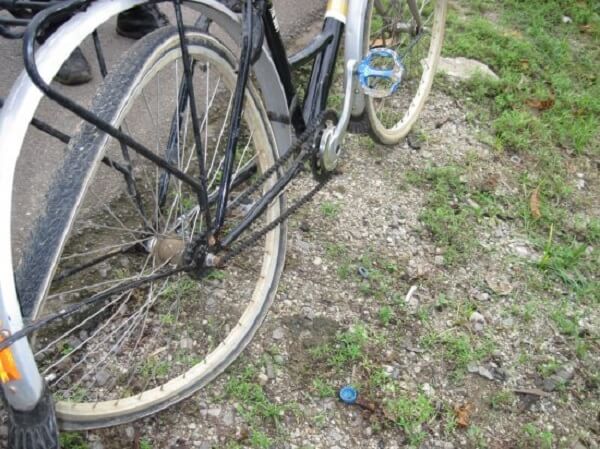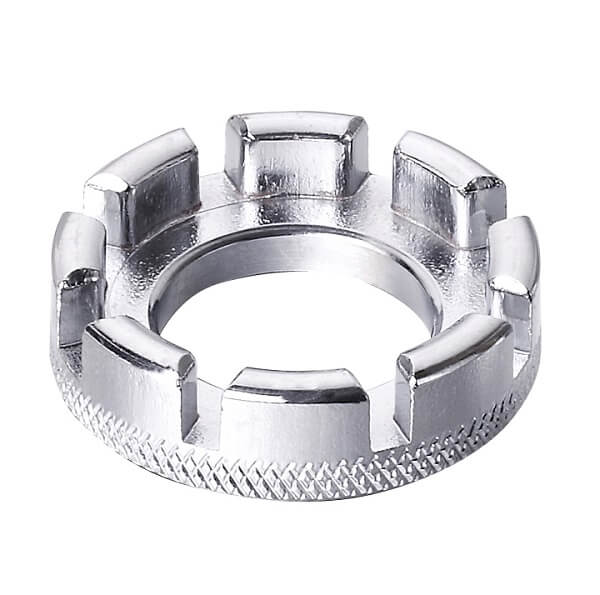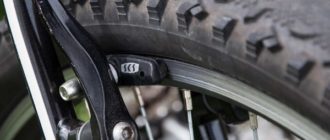The resulting “figure of eight” on the wheel is an unfortunate nuisance. While riding, you may feel the wobbling, wobbling or wobbling of the wheel, which eventually leads to a breakdown. So as not to go to the service every time a curvature is formed, it is important to know how to remove the figure of eight on the bike wheel. There are two effective ways.
Causes of the defect
The wheels of the bike are constantly exposed to loads. They can be:
- static;
- dynamic.
The first are relatively stable – it is the degree of tension of spokes or air pressure in the tube. This type of load either does not change at all, or changes occur very smoothly. Dynamic loads, in turn, are divided into three types:
- tension;
- compression;
- torsion.
Each type should be considered separately in order to determine the cause of the formation of the figure eight and ways to eliminate the defect.
Constant loads
The degree of tension of the spokes is a static load that provides a relatively stable state of the wheel. This is possible due to a combination of several factors: the equal degree of tension of all spokes, the absence of cracks, deformations and signs of metal “fatigue” on the rim, as well as the integrity of the hub flanges.
This is interesting! A perfectly assembled wheel can withstand enormous loads, for example, on 36 spokes – about 350 kg.
The pressure in the tube is of great importance. This factor depends on the type of wheel and model of the bike.
This is important! When pulling the wheel may make a slight crackling noise. This is normal and does not necessarily indicate a malfunction.
If the spokes are stretched unevenly, then after pumping the wheel, the rim may deform in a “figure of eight”. Sometimes you have to retighten the entire wheel itself to correct the situation.
Dynamic loads
They affect the wheel in motion, which eventually leads to deformation of the rim and spokes. Examples of dynamic loads on a wheel:
- The weight of the rider. Even if you don’t ride outside of smooth asphalt, there is a phenomenon such as metal “fatigue” over time anyway. Even if you just sit on the bike, the top two spokes will be under maximum load and the bottom two spokes will be under minimum load.
- Braking. This process causes torsional loads in which the total tension of the spokes is redistributed.
- Overcoming obstacles. Radial loading, in which the lower, already loaded spokes are further stressed, and the upper spokes are further loosened.
- Transverse loads. They occur on curves.
These factors fully answer the question of why a “figure of eight” forms. Particular attention should be paid to the rear wheel, as parallelogram derailleur designs are often found here. To properly install the star system, it is necessary to place the spokes in an asymmetrical order, so that they do not interfere with each other and the process of shifting gears.
Possible types of camber.
They can be divided into 2 groups: reversible and irreversible. There are 3 types of reversible bends that are more common:
- Eight – a curvature of one of the sections of the wheel.
- Egg – a process in which the rim takes the shape of an oval.
- Umbrella – the wheel deviates from the central part of the fork.
Irreversible defects can include rim dents, which can appear in both transverse and longitudinal directions. They appear most often after a strong mechanical impact (e.g., after an impact or collision). In this case, to straighten the wheel will not work, it is necessary to fully replace the rim, spokes, hub, that is to perform a comprehensive repair.
“Eight”.
This defect is a deflection of one of the sections of the rim from the vertical plane. As a result, there is a weakening and overtightening of some spokes. Several degrees are distinguished:
- Light. With this defect the rim remains intact and so do the spokes – you only need to adjust their tension. The run-out in this case is within 3 mm. This can be caused by typical metal fatigue. It is only necessary to tension the spokes properly.
- Medium. Deviation in this case already exceeds 3 mm, but the spokes and the rim remain intact. This defect occurs with minor shocks or collisions.
- Severe. The defect is so severe that the rim and spokes are also damaged. In this case, you only have to re-spoke the wheel, replacing the damaged elements.
You can remove the curvature with your own hands, or you can give the bike to a workshop so that an experienced master can straighten the figure-of-eight on the wheel. Here much depends on the extent of the problem, available tools and the necessary skills.
Necessary tools
The most important tool for eliminating the figure of eight is a spoke wrench. If there is, a bike rack will come in handy, which will allow you to securely fix the bike and quietly do the work at home. If you do not have it, you can just put the bike on the handlebars.
In any case, the basic tool is still a spoke wrench. There are two varieties: milled and stamped. The first version is more preferable, as such a model has clearer edges, and the quality of its manufacture is noticeably higher.
Methods of Detecting Warps
If you have suspicions, it remains only to determine the location of the defect, and then align the figure eight. To do this, you need to fix the bike in a special rack or turn it upside down and put it on the handlebars, fixing it securely. There are two methods of determination:
- Visual. Allows you to detect medium and large defects. You need to twist the wheel as hard as possible. The thing is, even the roughest 8’s may not be noticed on a slight spinning speed. The rear wheel can be pedaled at all. As a rule, the curved areas go away from the vertical plane of rotation to the side. Look closely as possible, and grasp the place of the greatest deflection of the wheel. This is not the best way, so it makes sense to use another method.
- Contact. Concludes in marking the curved area with a crayon. To do this, you need to spin the wheel and slowly move the chalk around the rim. The first thing it will do is touch the edge of the convex area. After you have found the “tip of the iceberg”, you only need to spin the wheel even harder and continue drawing with a chalk. Thus the whole area of distortion will be determined. For convenience, it is better to highlight the defective places with a bold line.
You can determine the “figure of eight” with the help of cotton swabs, marker and scotch tape. The sticks should be attached in a circle on the feathers of the rear fork, and then unscrew the wheel. The points of contact with the rim are the warps, which should be marked with a marker.
How to fix a figure of eight on a wheel
There are two proven ways to straighten an 8 wheel.
Power method
Step-by-step instructions for straightening:
- Dismantle the wheel and leave the tire along with the tube untouched.
- With the wheel dented toward you, hold both sides of the wheel so the angle between your knee and the center of the dent is 60.
- Press the knee against the curved area and push it toward you with force.
After all the manipulation you need to put the wheel in place and check its trajectory. It is clear that by force methods you will not be able to perfectly align the wheel. Therefore, it makes sense to get acquainted with the second method.
Adjustment of spokes
It is reduced to tightening and/or loosening of spokes in turns. Always start with the “central” spoke in the figure of eight, and then adjust the side elements in turn:
- On 3 spokes: tighten the center one a quarter turn, loosen the side ones a little, about 1/8 turn (the loosening should be half the force of the tension).
- On 7 spokes: tighten center 1/5, loosen side spokes by a quarter turn 2 and 3, tighten 4 and 5 by 1/8. Loosen the outermost (6 and 7) spokes by 1/8.
After that, you need to put the wheel back and assess the result of the work done.
This is important! After the repair work, you must check how securely fastened directly all the spokes. If this is not done, accidents can occur while driving, which is fraught with even greater losses for the wheel.
Prevention
Avoiding the appearance of the figure-of-eight is almost impossible. However, it is quite realistic to postpone this moment until as late as possible. The following factors are the prevention of the appearance of octahedrons:
- Careful and calm driving;
- When overcoming curbs, stairs and other obstacles you should dismount;
- it is better to use quality spokes for large wheels;
- use double rims (important for the frequent formation of octahedrons);
- Regular maintenance, which allows you to identify defects in the early stages.
To remove the figure of eight on the bicycle itself for the first time by adjusting the spokes is quite difficult. It is a painstaking process that requires a certain amount of skill. To correct the eight for the first time it is worth in the workshop, watching the work of a specialist, and then you can try and correct the situation yourself.
Conclusion
Wheel eight – this is a fairly common defect, which significantly affects the behavior of the bicycle. Leaving the situation unattended is not possible. It is possible to determine the place of formation of the defect and fix it yourself, but it is better to give the bike to a workshop, where it will be able to provide full-fledged assistance.














This is a great post! I never knew that figure of eights on a bicycle wheel could be caused by brake pads that are too tight, and it’s nice to have some clear instructions about how to fix the issue. Thanks for all the helpful information!